Effect of Polytetrafluoroethylene Coating on Corrosion Wear Properties of AZ31 Magnesium Alloy by Electrophoretic Deposition
Abstract
1. Introduction
2. Materials and Methods Applied
2.1. Materials
2.2. Preparation of PTFE Film
2.3. Methods Adopted for Testing
2.4. Property Testing
2.4.1. Contact Angle Testing
2.4.2. Corrosion Resistance Testing
2.4.3. Abrasion Resistance Testing
3. Results and Discussion
3.1. Characterization of Zeta Potential
3.2. Characterization of Coatings
3.3. Contact Surface Micro-Nano Morphology and Contact Angle
3.4. Corrosion Resistance Measurement
3.5. Wear Performance Testing
3.5.1. Coefficient of Friction
3.5.2. Abrasion Loss
3.5.3. Wear Morphology
3.5.4. Abrasion Mechanism
3.5.5. Comparison of Properties Improved by EDP with Other Literature Reported
4. Conclusions
- (1)
- PEI can adsorb onto PTFE, and under the action of H+, PEI transforms into PEI-H+ ions, which are absorbed onto the polytetrafluoroethylene, giving PTFE a positive charge and depositing onto the cathodic substrate. By controlling different deposition times, PTFE coatings of varying thicknesses can be electrophoretically deposited on the surface of AZ31 magnesium alloy.
- (2)
- Through corrosion tests in a 3.5 wt% NaCl solution, we found that the self-corrosion current of AZ31 magnesium alloy decreased by approximately an order of magnitude after electrophoretic deposition of PTFE coating. Additionally, the impedance of AZ31 magnesium alloy with PTFE coatings deposited for 5 min, 10 min, and 15 min increased by 2-fold, 3-fold, and 7-fold, respectively, compared to the untreated sample. Combining polarization curves, electrochemical impedance, and hydrogen evolution corrosion, it can be concluded that the corrosion resistance of AZ31 magnesium alloy is improved after electrophoretic deposition of PTFE coating.
- (3)
- Dry sliding wear tests of AZ31 magnesium alloy before and after electrophoretic deposition of PTFE coating showed that under a 1 N load, the wear volume of AZ31 magnesium alloy decreased by two orders of magnitude after electrophoretic deposition of PTFE coating for 10 and 15 min. The wear mechanism of magnesium alloy involves cutting plowing wear, as well as abrasive wear and oxidative wear. The wear mechanism of electrophoretic deposition of PTFE coating includes the mechanical barrier effect and self-lubricating action of PTFE.
- (4)
- The optimal deposition time in this experiment is 10 min. The abrasion mechanism of the AZ31 magnesium alloy with a 10 min deposited PTFE coating is similar to that of the coating deposited for 15 min. As the deposition time increases, the abrasion mechanism does not improve significantly, indicating that the lubricating and protective effect of the C-F bonds in PTFE reaches a critical point at 10 min.
Author Contributions
Funding
Institutional Review Board Statement
Informed Consent Statement
Data Availability Statement
Conflicts of Interest
References
- Jianwei, L.; Youmin, Q.; Junjie, Y.; Sheng, Y.; Yanliang, Y.; Xun, Z.; Lianxi, C.; Fengliang, Y.; Jiangzhou, S.; Zhang, T. Effect of grain refinement induced by wire and arc additive manufacture (WAAM) on the corrosion behaviors of AZ31 magnesium alloy in NaCl solution. J. Magnes. Alloys 2023, 11, 217–229. [Google Scholar] [CrossRef]
- Song, J.; She, J.; Chen, D.; Pan, F. Latest research advances on magnesium and magnesium alloys worldwide. J. Magnes. Alloys 2020, 8, 1–41. [Google Scholar] [CrossRef]
- Cui, L.-Y.; Gao, S.-D.; Li, P.-P.; Zeng, R.-C.; Zhang, F.; Li, S.-Q.; Han, E.-H. Corrosion resistance of a self-healing micro-arc oxidation/polymethyltrimethoxysilane composite coating on magnesium alloy AZ31. Corros. Sci. 2017, 118, 84–95. [Google Scholar] [CrossRef]
- Wu, G.; Zhao, D.; Lin, X.; Liu, J.; Ji, X. Investigation of an environmentally friendly coloring coating for magnesium-lithium alloy micro-arc oxidation. Surf. Interfaces 2020, 20, 100513. [Google Scholar] [CrossRef]
- Peng, X.; Liu, W.; Wu, G.; Ji, H.; Ding, W. Plastic deformation and heat treatment of Mg-Li alloys: A review. J. Mater. Sci. Technol. 2022, 99, 193–206. [Google Scholar] [CrossRef]
- Tong, L.; Zheng, M.; Xu, S.; Kamado, S.; Du, Y.; Hu, X.; Wu, K.; Gan, W.; Brokmeier, H.; Wang, G. Effect of Mn addition on microstructure, texture and mechanical properties of Mg–Zn–Ca alloy. Mater. Sci. Eng. A 2011, 528, 3741–3747. [Google Scholar] [CrossRef]
- Fan, Y.; Wu, G.; Zhai, C. Influence of cerium on the microstructure, mechanical properties and corrosion resistance of magnesium alloy. Mater. Sci. Eng. A 2006, 433, 208–215. [Google Scholar] [CrossRef]
- Duan, G.; Yang, L.; Liao, S.; Zhang, C.; Lu, X.; Yang, Y.; Zhang, B.; Wei, Y.; Zhang, T.; Yu, B. Designing for the chemical conversion coating with high corrosion resistance and low electrical contact resistance on AZ91D magnesium alloy. Corros. Sci. 2018, 135, 197–206. [Google Scholar] [CrossRef]
- Lin, Z.; Wang, T.; Yu, X.; Sun, X.; Yang, H. Functionalization treatment of micro-arc oxidation coatings on magnesium alloys: A review. J. Alloys Compd. 2021, 879, 160453. [Google Scholar] [CrossRef]
- Wang, G.; Song, D.; Qiao, Y.; Cheng, J.; Liu, H.; Jiang, J.; Ma, A.; Ma, X. Developing super-hydrophobic and corrosion-resistant coating on magnesium-lithium alloy via one-step hydrothermal processing. J. Magnes. Alloys 2023, 11, 1422–1439. [Google Scholar] [CrossRef]
- Song, W.; Zhao, X.; Jin, Z.; Fan, L.; Ji, X.; Deng, J.; Duan, J. Poly(vinyl alcohol) for multi-functionalized corrosion protection of metals: A review. J. Clean. Prod. 2023, 394, 136390. [Google Scholar] [CrossRef]
- Zhou, H.J.; Liu, X.Q.; Su, Q. Development of study on electrophoretic deposition preparing functional thin films. Mater. Rep. 2008, 22, 311–315. [Google Scholar]
- An, S.J.; Zhu, Y.; Lee, S.H.; Stoller, M.D.; Emilsson, T.; Park, S.; Velamakanni, A.; An, J.; Ruoff, R.S. Thin film fabrication and simultaneous anodic reduction of deposited graphene oxide platelets by electrophoretic deposition. J. Phys. Chem. Lett. 2010, 1, 1259–1263. [Google Scholar] [CrossRef]
- Liu, X.; Qian, T.; Xu, N.; Zhou, J.; Guo, J.; Yan, C. Preparation of on chip, flexible supercapacitor with high performance based on electrophoretic deposition of reduced graphene oxide/polypyrrole composites. Carbon 2015, 92, 348–353. [Google Scholar] [CrossRef]
- Kiran, N.U.; Dey, S.; Singh, B.P.; Besra, L. Graphene coating on copper by electrophoretic deposition for corrosion prevention. Coatings 2017, 7, 214. [Google Scholar] [CrossRef]
- Yang, Y.; Xiong, X.; Chen, J.; Peng, X.; Chen, D.; Pan, F. Research advances in magnesium and magnesium alloys worldwide in 2020. J. Magnes. Alloys 2021, 9, 705–747. [Google Scholar] [CrossRef]
- Yang, W.D.; Huang, J.F.; Cao, L.Y.; Xia, C.K. Hydrothermal electrophoretic deposition technology and its application in preparing functional coatings. Mater. Rev. 2010, 24, 44–48. [Google Scholar]
- Zhang, R.; Zhao, J.; Liang, J. A novel multifunctional PTFE/PEO composite coating prepared by one-step method. Surf. Coat. Technol. 2016, 299, 90–95. [Google Scholar] [CrossRef]
- Zhao, Q.; Liu, X.; Zhitomirsky, I. Electrophoretic deposition of materials using lithocholic acid as a dispersant. Mater. Lett. 2020, 275, 128129. [Google Scholar] [CrossRef]
- Liu, X.; Zhao, Q.; Veldhuis, S.; Zhitomirsky, I. Cholic acid is a versatile coating-forming dispersant for electrophoretic deposition of diamond, graphene, carbon dots and polytetrafluoroethylene. Surf. Coat. Technol. 2020, 384, 125304. [Google Scholar] [CrossRef]
- Zhao, Q.; Liu, X.; Veldhuis, S.; Zhitomirsky, I. Sodium deoxycholate as a versatile dispersing and coating-forming agent: A new facet of electrophoretic deposition technology. Colloids Surf. A Physicochem. Eng. Asp. 2020, 588, 124382. [Google Scholar] [CrossRef]
- Wang, X.; Wang, B.-B.; Yang, W.; Zhao, Q.; Xu, Z.-M.; Yan, W.-M. Fabrication of stable and versatile superhydrophobic PTFE coating by simple electrodeposition on metal surface. Prog. Org. Coat. 2022, 172, 107090. [Google Scholar] [CrossRef]
- Bansal, A.; Singh, J.; Singh, H.; Goyal, D.K. Influence of thickness of hydrophobic polytetrafluoroethylene (PTFE) coatings on cavitation erosion of hydro-machinery steel SS410. Wear 2021, 477, 203886. [Google Scholar] [CrossRef]
- Yu, Y.; Chen, L.; Weng, D.; Wang, J.; Chen, C.; Mahmood, A. A promising self-assembly PTFE coating for effective large-scale deicing. Prog. Org. Coat. 2020, 147, 105732. [Google Scholar] [CrossRef]
- Farrokhi-Rad, M.; Mohammadalipour, M.; Shahrabi, T. Electrophoretically deposited halloysite nanotubes coating as the adsorbent for the removal of methylene blue from aqueous solution. J. Eur. Ceram. Soc. 2018, 38, 3650–3659. [Google Scholar] [CrossRef]
- Besra, L.; Liu, M. A review on fundamentals and applications of electrophoretic deposition (EPD). Prog. Mater. Sci. 2007, 52, 1–61. [Google Scholar]
- Wang, S.; Wang, Y.; Zou, Y.; Wu, Y.; Chen, G.; Ouyang, J.; Jia, D.; Zhou, Y. A self-adjusting PTFE/TiO2 hydrophobic double-layer coating for corrosion resistance and electrical insulation. Chem. Eng. J. 2020, 402, 126116. [CrossRef]
- Sahu, B.P.; Sarangi, C.K.; Mitra, R. Effect of Zr content on structure property relations of Ni-Zr alloy thin films with mixed nanocrystalline and amorphous structure. Thin Solid Film 2018, 660, 31–45. [Google Scholar] [CrossRef]
- Zhou, X.; Shi, W.; Xiang, S. Improving corrosion resistance of Zn-5Al(wt%)alloy by microalloying with samarium. J. Rare Earths 2023, 41, 1636–1644. [Google Scholar] [CrossRef]
- Guo, L.; Huang, Q.; Zhang, C.; Wang, J.; Shen, G.; Ban, C.; Guo, L. Study on the formation of Mn-P coatings with significant corrosion resistance on Q235 carbon steels by adjusting the ratio of phosphorus to manganese. Corros. Sci. 2021, 178, 108960. [Google Scholar] [CrossRef]
- Song, J.; Zhao, G. A molecular dynamics study on water lubrication of PTFE sliding against copper. Tribol. Int. 2019, 136, 234–239. [Google Scholar] [CrossRef]
- Maksoud, A.; Ahmed, H.; Rödel, J. Investigation of the effect of strain rate and temperature on the deformability and microstructure evolution of AZ31 magnesium alloy. Mater. Sci. Eng. A 2009, 504, 40–48. [Google Scholar] [CrossRef]
- Jiang, X.; Dai, Y.; Xiang, Q.; Liu, J.; Yang, F.; Zhang, D. Microstructure and wear behavior of inductive nitriding layer in Ti–25Nb–3Zr–2Sn–3Mo alloys. Surf. Coat. Technol. 2021, 427, 127835. [Google Scholar] [CrossRef]
- Dhanumalayan, E.; Joshi, G.M. Performance properties and applications of polytetrafluoroethylene (PTFE)—A review. Adv. Compos. Hybrid Mater. 2018, 1, 247–268. [Google Scholar] [CrossRef]
- Wu, W.; Zhang, F.; Li, Y.C.; Song, L.; Jiang, D.; Zeng, R.C.; Tjong, S.C.; Chen, D.C. Corrosion resistance of dodecanethiol-modified magnesium hydroxide coating on AZ31 magnesium alloy. Appl. Phys. A 2020, 126, 8. [Google Scholar] [CrossRef]
- Ahangari, M.; Johar, M.; Saremi, M. Hydroxyapatite-carboxymethyl cellulose-graphene composite coating development on AZ31 magnesium alloy: Corrosion behavior and mechanical properties. Ceram. Int. 2021, 47, 3529–3539. [Google Scholar] [CrossRef]
- Wu, L.; Ding, X.; Zheng, Z.; Ma, Y.; Atrens, A.; Chen, X.; Xie, Z.; Sun, D.; Pan, F. Fabrication and characterization of an actively protective Mg-Al LDHs/Al2O3 composite coating on magnesium alloy AZ31. Appl. Surf. Sci. 2019, 487, 558–568. [Google Scholar] [CrossRef]
- Zucchi, F.; Frignani, A.; Grassi, V.; Balbo, A.; Trabanelli, G. Organo-silane coatings for AZ31 magnesium alloy corrosion protection. Mater. Chem. Phys. 2008, 110, 263–268. [Google Scholar] [CrossRef]
- Sreekanth, D.; Rameshbabu, N. Development and characterization of MgO/hydroxyapatite composite coating on AZ31 magnesium alloy by plasma electrolytic oxidation coupled with electrophoretic deposition. Mater. Lett. 2012, 68, 439–442. [Google Scholar] [CrossRef]
- Asl, S.K.F.; Nemeth, S.; Tan, M. Electrophoretic deposition of hydroxyapatite coatings on AZ31 magnesium substrate for biodegradable implant applications. Prog. Cryst. Growth Charact. Mater. 2014, 60, 74–79. [Google Scholar] [CrossRef]
- Jumah, A.J.S. Characterization corrosion behavior of nano alumina coatings on Al12Si fabricated by electrophoretic deposition. Diyala J. Eng. Sci. 2014, 7, 99–114. [Google Scholar] [CrossRef]
- Rojaee, R.; Fathi, M.; Raeissi, K. Electrophoretic deposition of nanostructured hydroxyapatite coating on AZ91 magnesium alloy implants with different surface treatments. Appl. Surf. Sci. 2013, 285, 664–673. [Google Scholar] [CrossRef]
- Kumar, R.M.; Kuntal, K.K.; Singh, S.; Gupta, P.; Bhushan, B.; Gopinath, P.; Lahiri, D. Electrophoretic deposition of hydroxyapatite coating on Mg–3Zn alloy for orthopaedic application. Surf. Coat. Technol. 2016, 287, 82–92. [Google Scholar] [CrossRef]

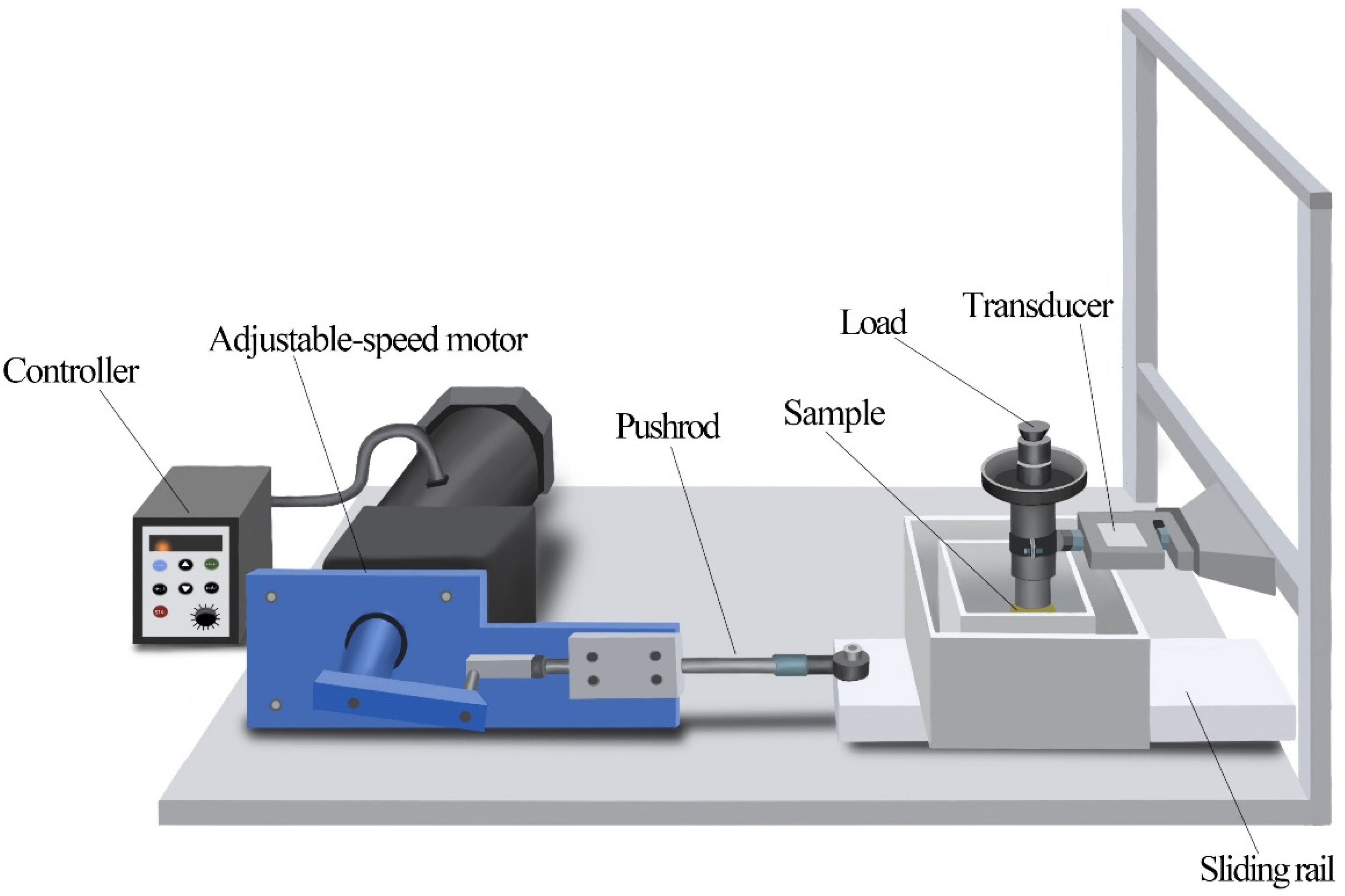

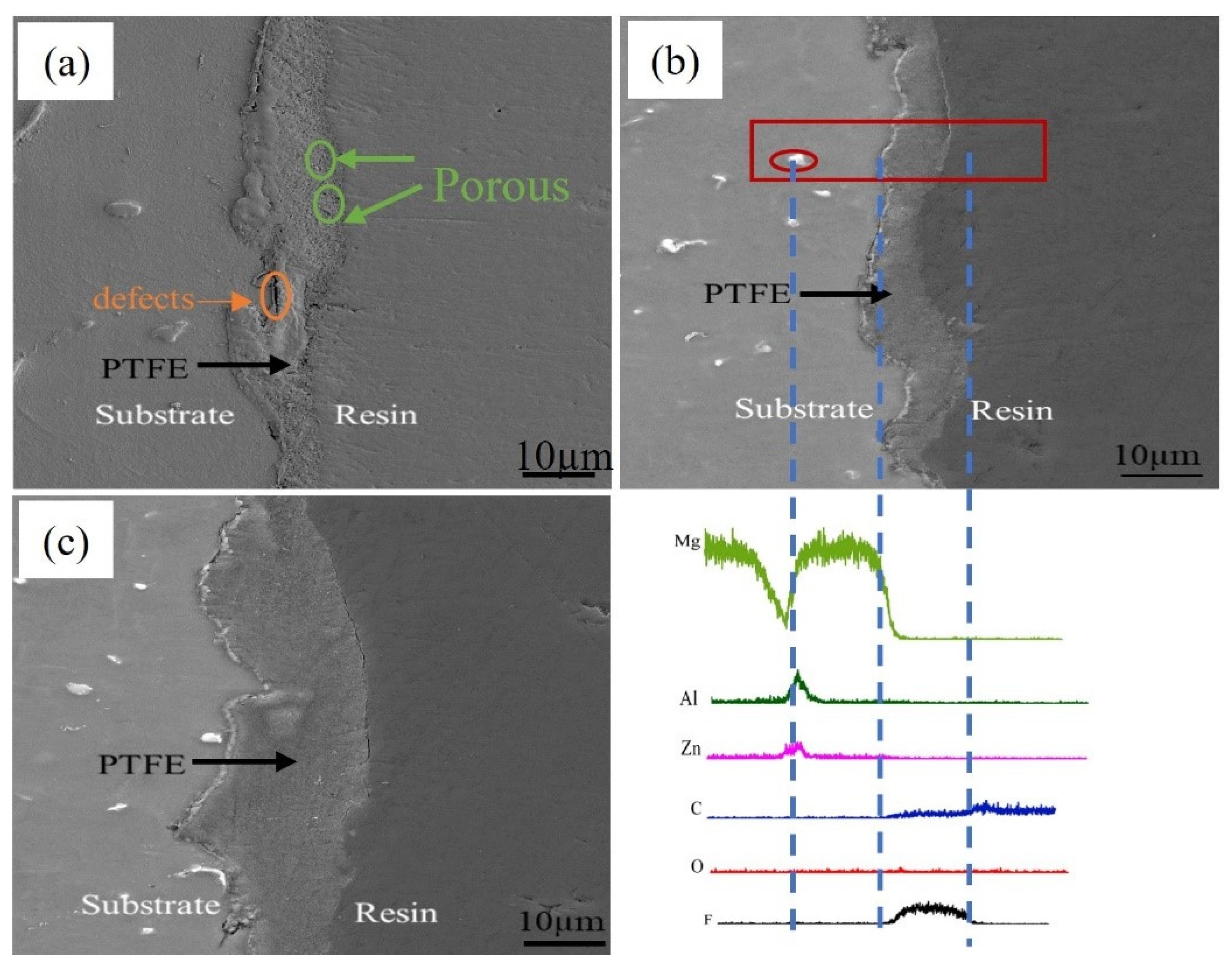


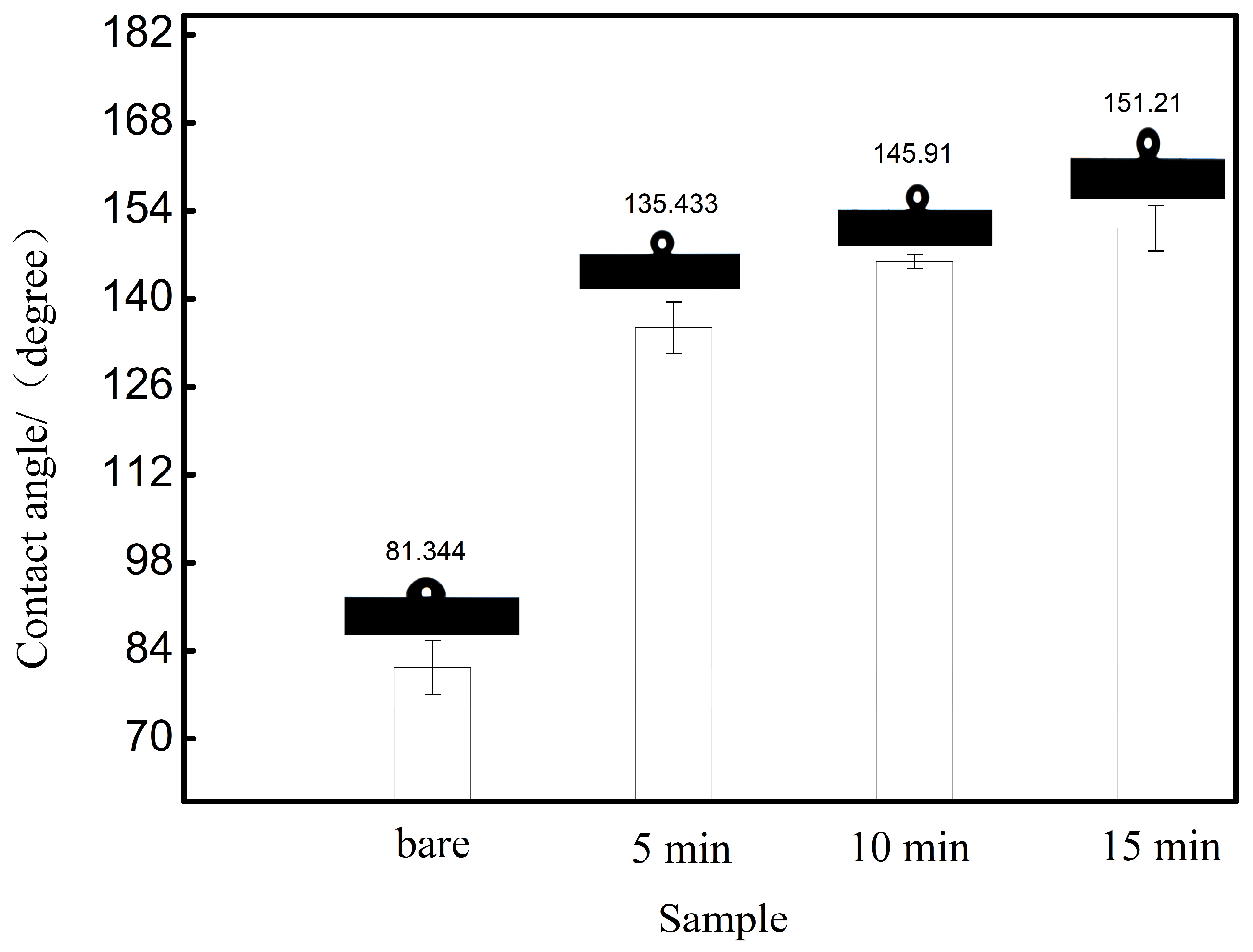
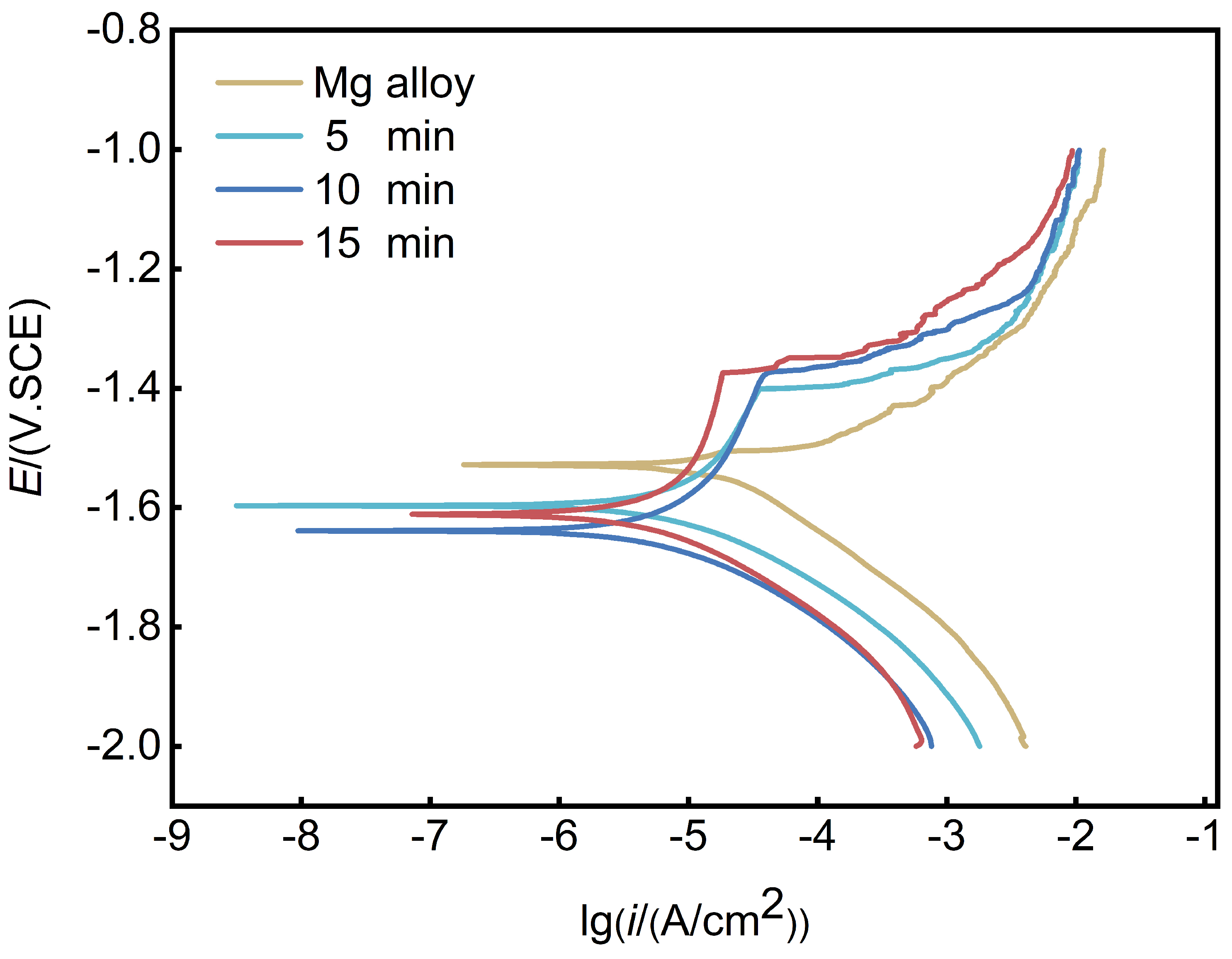
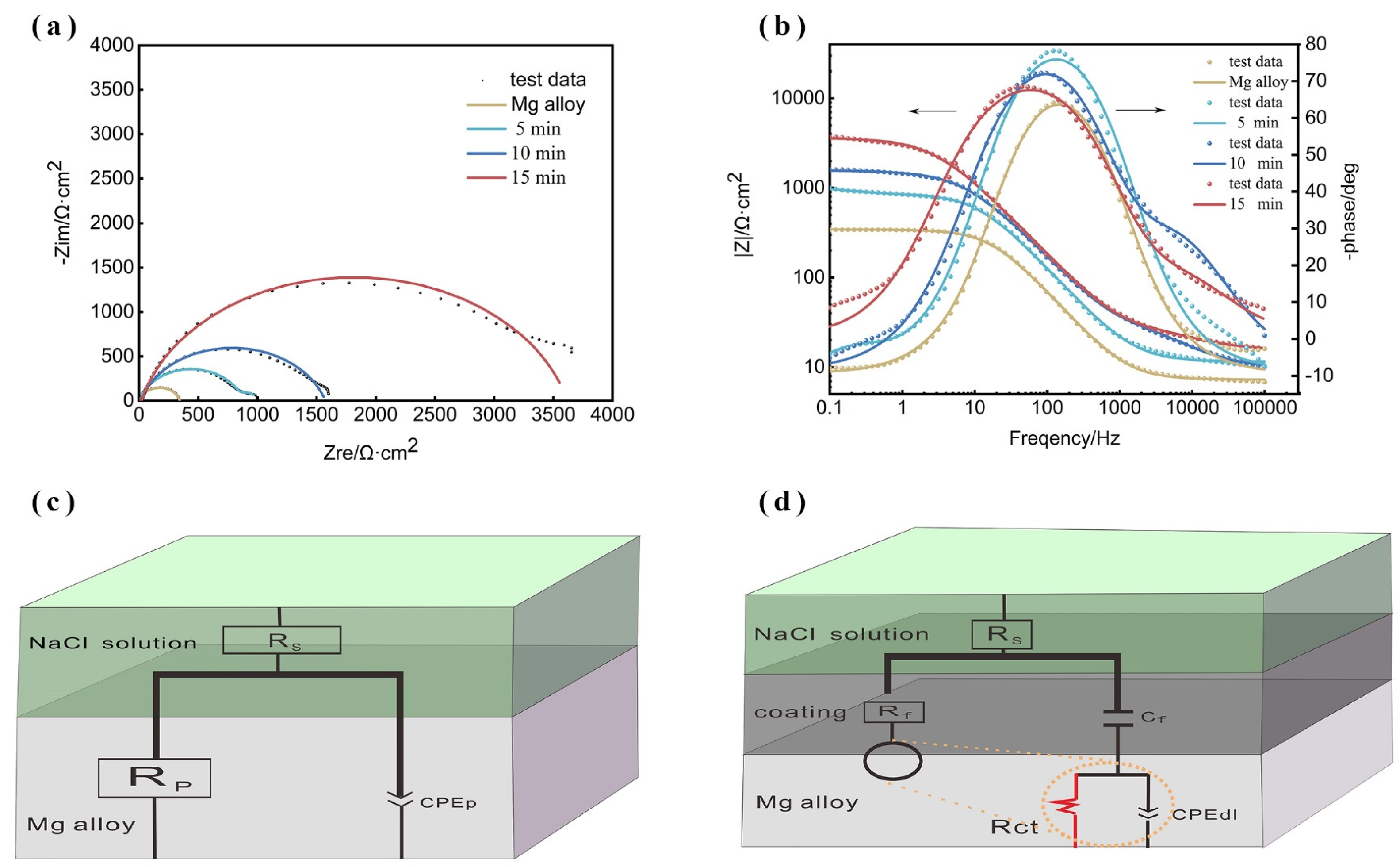

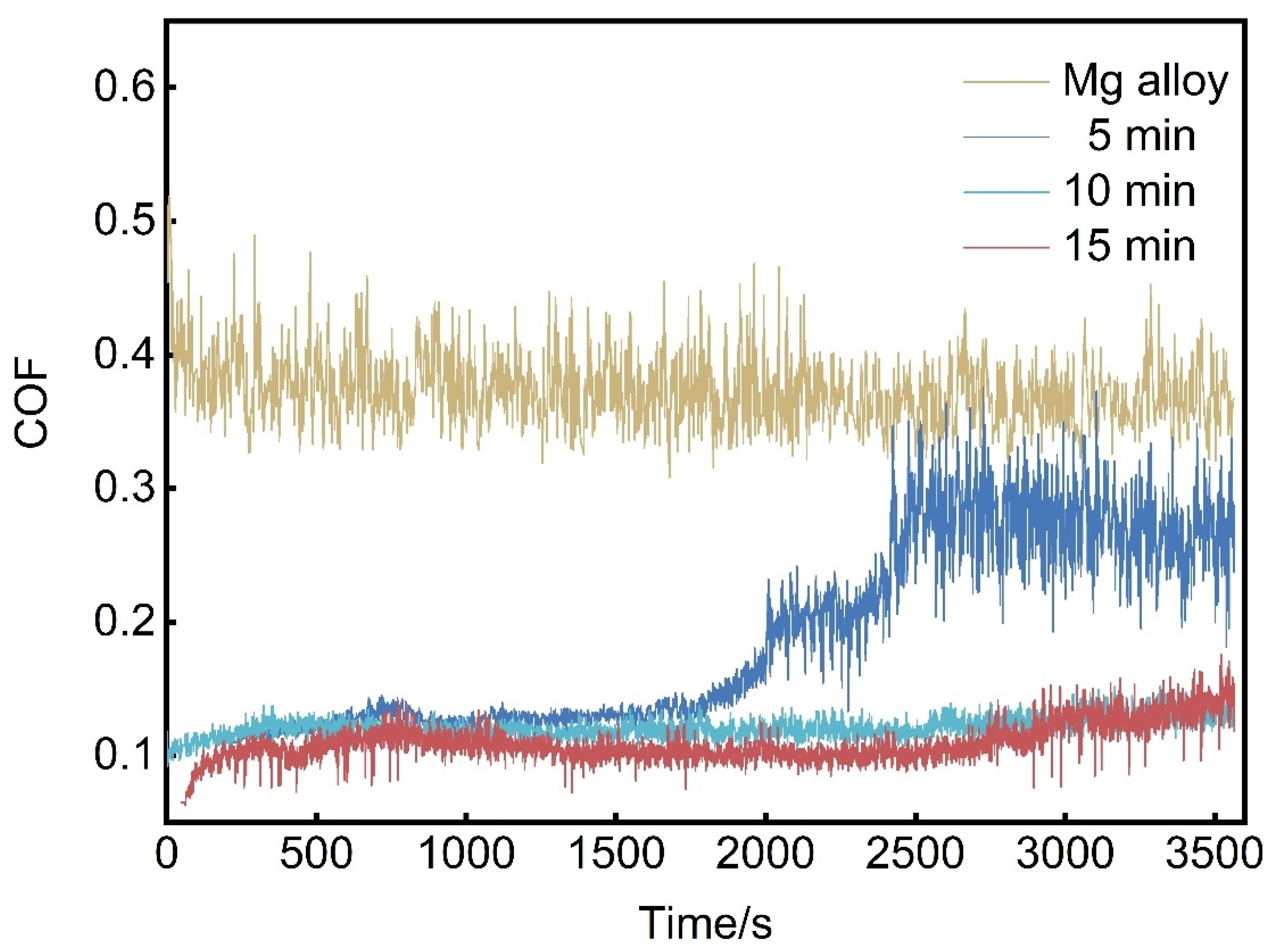
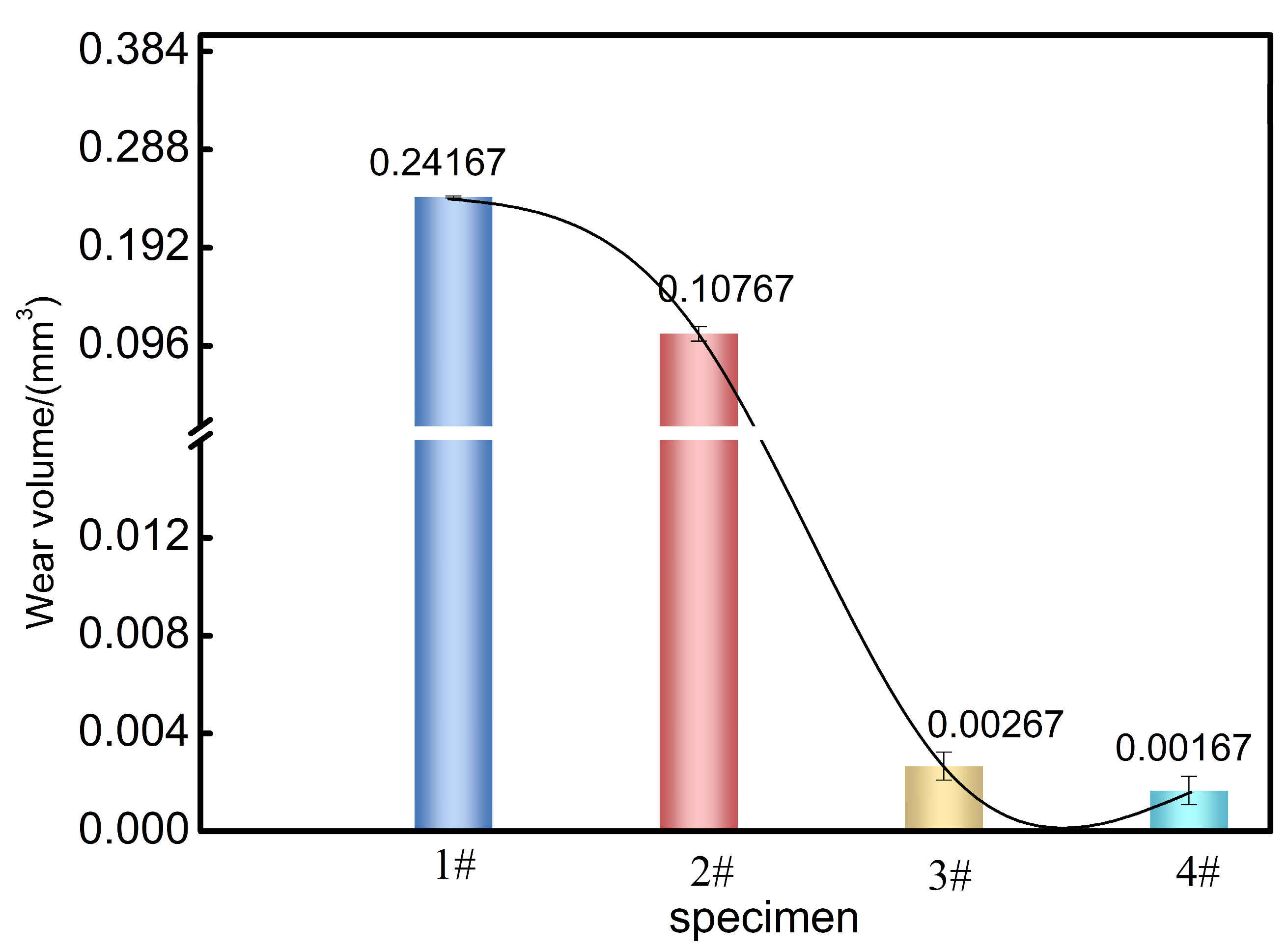

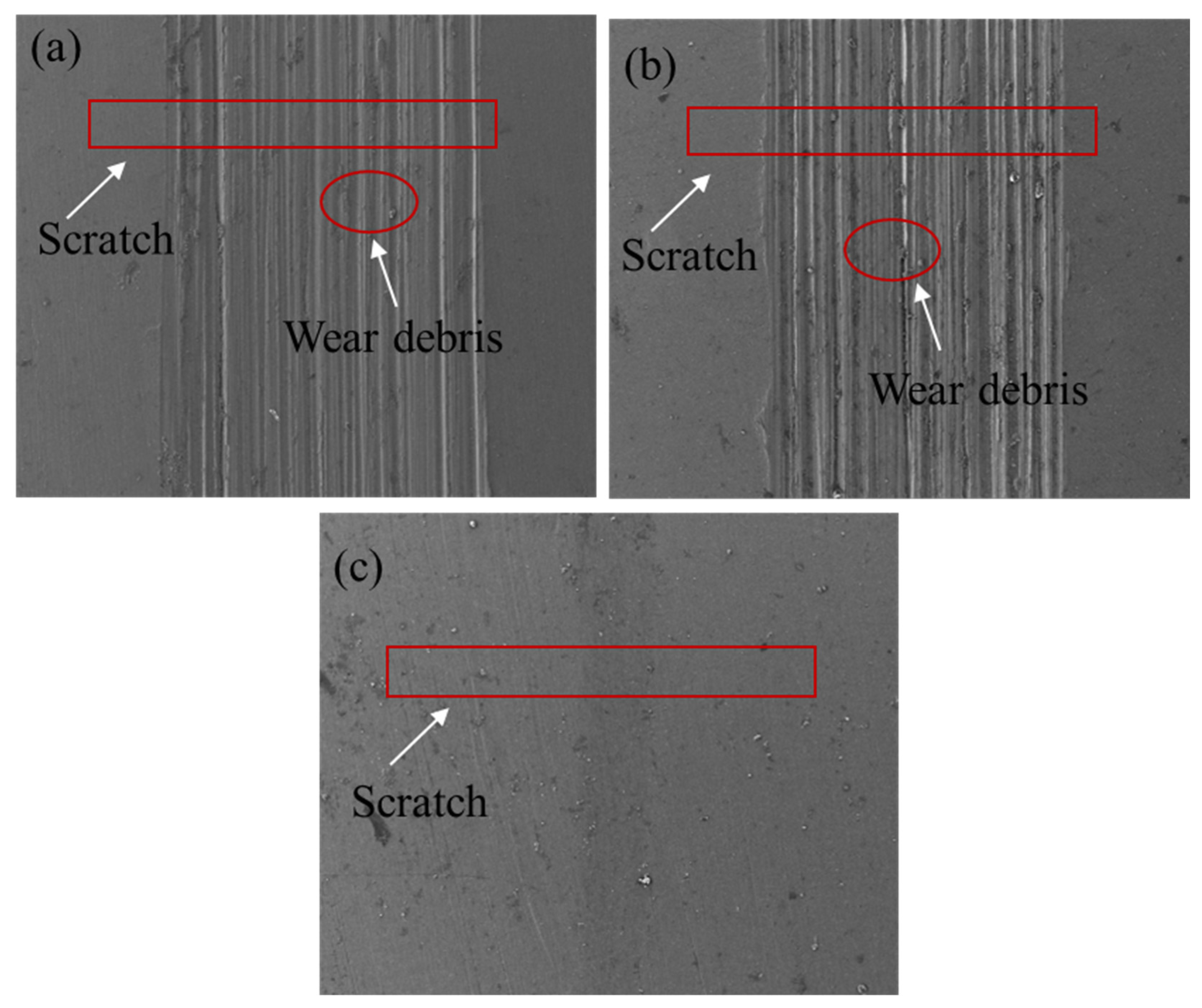
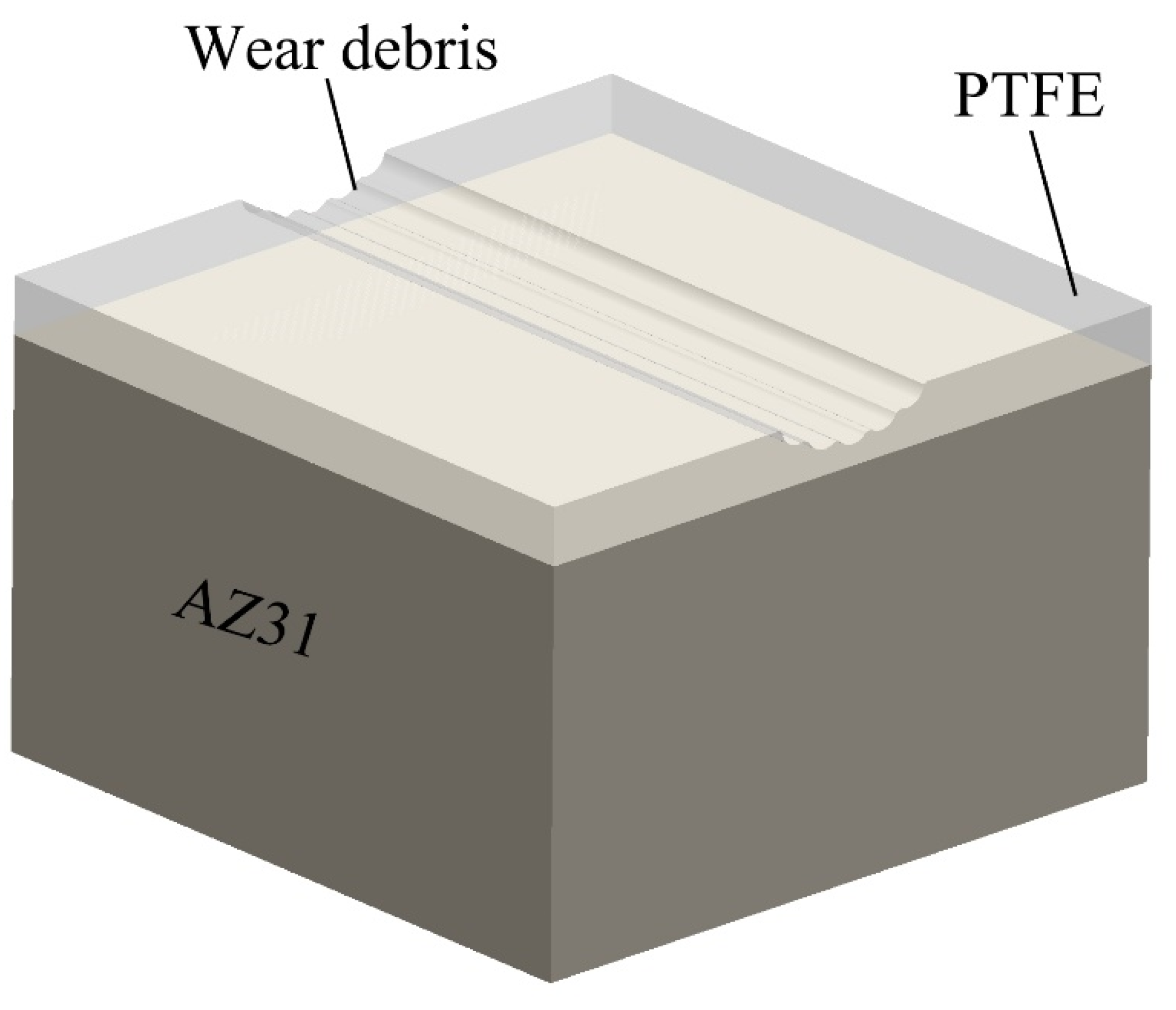
| Sample | P1 | P2 | P3 |
|---|---|---|---|
| Zeta potential/(mV) | 5.7267 | 20.7 | 33.4667 |
| Conductivity/(mS/cm) | 0.0388 | 0.0051 | 0.0089 |
| Deposited Time | Ecorr/(V) | icorr/(µA/m2) | βα/(mV·dec−1) | βC/(mV·dec−1) | Corrosion Rate (mm/a) |
|---|---|---|---|---|---|
| 0 | −1.54 | 67.5 | 126 | 192 | 0.305 |
| 5 min | −1.62 | 16.3 | 257 | 285 | 0.262 |
| 10 min | −1.67 | 9.6 | 278 | 296 | 0.251 |
| 15 min | −1.63 | 5.2 | 365 | 332 | 0.246 |
| Specimens | Rf /(Ω·cm2) | Cf | n | Rct/(Ω·cm2) | CPE /(Ω−1cm−2sn) | RP /(Ω·cm2) |
|---|---|---|---|---|---|---|
| bare | 0.9 | 4.2 × 10−5 | 337.3 | |||
| 5 min | 5.456 | 2.96 × 10−6 | 0.87 | 124.6 | 2.27 × 10−5 | 130.056 |
| 10 min | 15.76 | 1.25 × 10−6 | 0.82 | 1544 | 2.65 × 10−5 | 1559.76 |
| 15 min | 10.23 | 1.16 × 10−6 | 0.83 | 3589 | 2.37 × 10−5 | 3599.23 |
Disclaimer/Publisher’s Note: The statements, opinions and data contained in all publications are solely those of the individual author(s) and contributor(s) and not of MDPI and/or the editor(s). MDPI and/or the editor(s) disclaim responsibility for any injury to people or property resulting from any ideas, methods, instructions or products referred to in the content. |
© 2024 by the authors. Licensee MDPI, Basel, Switzerland. This article is an open access article distributed under the terms and conditions of the Creative Commons Attribution (CC BY) license (https://creativecommons.org/licenses/by/4.0/).
Share and Cite
Zhang, J.; Chen, C.; Li, J.; Chen, L. Effect of Polytetrafluoroethylene Coating on Corrosion Wear Properties of AZ31 Magnesium Alloy by Electrophoretic Deposition. Coatings 2024, 14, 664. https://doi.org/10.3390/coatings14060664
Zhang J, Chen C, Li J, Chen L. Effect of Polytetrafluoroethylene Coating on Corrosion Wear Properties of AZ31 Magnesium Alloy by Electrophoretic Deposition. Coatings. 2024; 14(6):664. https://doi.org/10.3390/coatings14060664
Chicago/Turabian StyleZhang, Jilun, Chaoyi Chen, Junqi Li, and Li Chen. 2024. "Effect of Polytetrafluoroethylene Coating on Corrosion Wear Properties of AZ31 Magnesium Alloy by Electrophoretic Deposition" Coatings 14, no. 6: 664. https://doi.org/10.3390/coatings14060664
APA StyleZhang, J., Chen, C., Li, J., & Chen, L. (2024). Effect of Polytetrafluoroethylene Coating on Corrosion Wear Properties of AZ31 Magnesium Alloy by Electrophoretic Deposition. Coatings, 14(6), 664. https://doi.org/10.3390/coatings14060664





